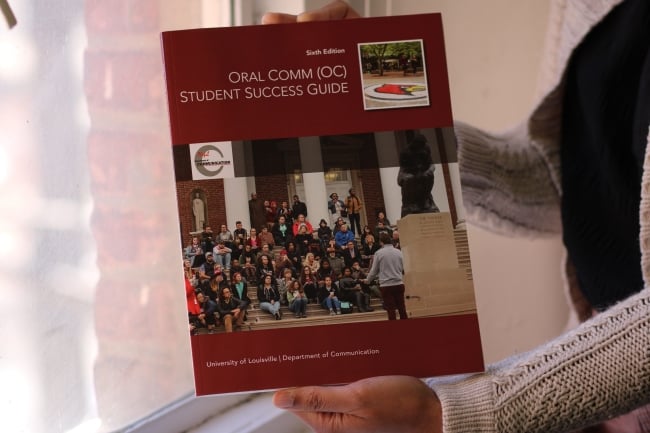You have /5 articles left.
Sign up for a free account or log in.

In addition to providing helpful academic guidance, the Oral Comm Success Guide guides learners to other support services on campus.
University of Louisville
A majority of college students say they’re unaware of all the services provided to them by their college or university, and a lack of awareness is tied to stopping out of college, according to research from Tyton Partners.
The Department of Communication at the University of Louisville College of Arts and Sciences created a digital textbook to support students as they complete a general education requirement and excel in their courses beyond.
The Oral Communication Student Success Guide accompanies learners enrolled in a public speaking course and provides information regarding campus resources as well as study skills.
How it works: All students enrolled in the College of Arts and Sciences complete an oral communication course as part of the general education requirements, which could include topics like public speaking, business speaking, virtual communication or interpersonal skills.
The guide first started around 12 years ago as a way to provide structure to the general education course for students and instructors, creating more transparency regarding assignments and grading rubrics, says Katherine Taylor, faculty member and director of the Oral Communication Basic Course.
The first version of the guide was a paper copy that students had to purchase with the textbook. Now, the sixth edition of the guide is online and has additional links and resources for learners to thrive while in college, including wellness services on campus, the national suicide hotline and organizational and study tips.
Survey Says
Data from Bay View Analytics finds the price of textbooks can impact students’ financial wellness, with 70 percent of undergraduate respondents to a 2023 survey saying they were at least slightly worried about meeting course material costs, with the greatest share of respondents spending more than $300 on course materials.
This concern is generally understood and reflected in instructors’ preferences; a 2024 survey from the National Association of College Stores identified affordability as a top priority for faculty members when selecting their textbooks.
Taylor and her colleagues have tried to compile resources across campus to reinforce information that students may not know about or only heard once before during orientation. In addition to direct links, the guide includes telephone or email information so students can reach out directly for help.
As part of the university’s inclusive access course materials model, all students receive access to the online resource through Blackboard and Achieve by MacMillan Learning as soon as they enroll.
What’s the need: The guide is a way to reach students where they are without devoting instructor time or resources to covering subjects in class, says Elyssa Smith, a faculty member in the oral communication program. Now, faculty can point students to a specific chapter to answer questions or just encourage learners to flip through the guide on their own.
One of the benefits of the digital resource is its functionality, because students can use it wherever they are. A 2024 survey from Bay View Analytics found 81 percent of faculty members believe digital textbooks allow students to have more flexibility in their learning.
Student access is attached to their Blackboard site for the semester, but they can download the book or print a paper copy if they’d like to continue referencing it beyond their first year of access.
Campus Spotlight
A professor at the University of Cincinnati at Clermont wrote an open-access textbook for her accounting students that includes video lectures, written content, embedded quizzes and other resources. Listen to Patty Goedl talk about her textbook in a podcast episode or read the article here.
In addition to supporting students, the success guide helps create a framework for instructors in the oral communication program while still allowing flexibility in pedagogy. The University of Louisville employs a variety of instructors to teach oral communication courses, including full-time, adjunct and part-time professors as well as graduate students. The guide allows instructors to teach to their strengths while still creating similarity in speech requirements and expectations, Taylor says.
The impact: The sixth edition of the success guide became available to learners in August, and already, Taylor says she has seen a difference in the work submitted by her upper-level oral communication students and their overall preparation levels for her course. She attributes this largely to the guide and how it provides students with guidance for high-quality work.
“I was blown away,” she says.
Anecdotal feedback from students and faculty helps campus leaders establish what content is needed in the guide, which Taylor and Smith update annually for the paper version and more regularly for the online version.
In the future, Smith says a focus is continuing to identify gaps in awareness for students in the classroom to help meet them where they are.
Do you have an academic intervention that might help others improve student success? Tell us about it.








